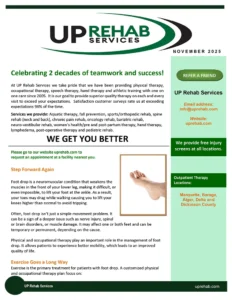Click here to download our full newsletter

Step Forward Again
Foot drop is a neuromuscular condition that weakens the muscles in the front of your lower leg, making it difficult, or even impossible, to lift your foot at the ankle. As a result, your toes may drag while walking causing you to lift your knees higher than normal to avoid tripping
Often, foot drop isn’t just a simple movement problem. It can be a sign of a deeper issue such as nerve injury, spinal or brain disorders, or muscle damage. It may affect one or both feet and can be temporary or permanent, depending on the cause.
Physical and occupational therapy play an important role in the management of foot drop. It allows patients to experience better mobility, which leads to an improved quality of life.
Exercise Goes a Long Way
Exercise is the primary treatment for patients with foot drop. A customized physical and occupational therapy plan focus on:
- Strengthening the muscles of the foot, ankle, and lower leg
- Stretching tight calf and foot muscles to restore flexibility
- Improving mobility for better control and balance
Try this simple at-home stretch:
Sit on the floor, loop a towel around your foot, hold both ends, and gently pull the towel toward you. This stretch targets your calf and helps improve ankle control.
Other beneficial exercises include toe curls and ankle flexes, which are best performed under the guidance of a licensed therapist to ensure safety and effectiveness.
Electrical Stimulation
In some patients with foot drop, physical and occupational therapists may advise a treatment regime that includes electrical stimulations of the nerves and muscle fibers. This helps generate electrical impulses within the muscles and can, to an extent, help increase the tone and the contractility.
Gait Training
Gait training helps retrain how you walk, improving balance, coordination, and confidence. Therapists may use:
- Walkers, canes, or parallel bars for support
- Gait belts for safety and balance
- Strength and balance exercises tailored to your condition
Braces and Splints
For individuals with limited control over their foot muscles, an “Ankle-Foot-Orthosis (AFO)” is used to help improve gait. AFO are L-shaped braces designed to support the function of the ankle and foot by keeping them perpendicular (at an angle of 90 degrees). This helps to keep the foot off of the ground while walking.
The Road to Recovery
Foot drop can be challenging, but with the right physical and occupational therapy program, you can regain mobility, confidence, and independence.
We are here to guide you through every step of your recovery journey.
Together, we will help you walk stronger, steadier, and with renewed confidence.